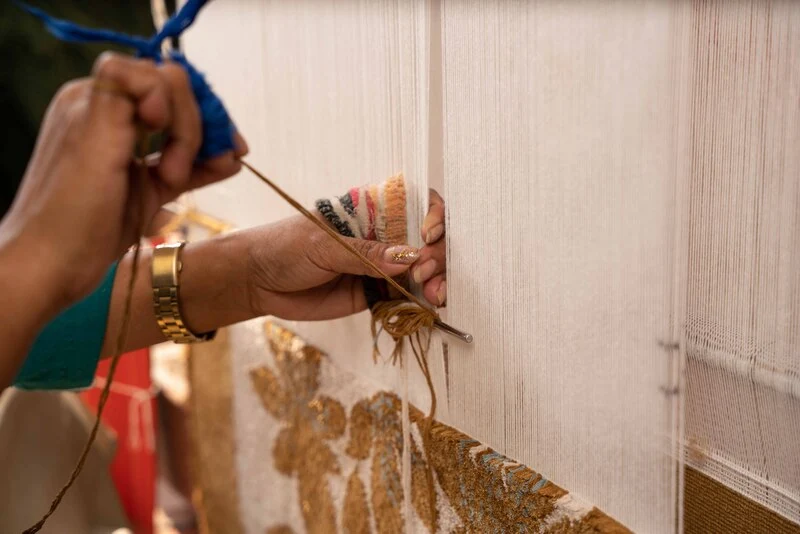If you’re searching for hand-knotted rug techniques, traditional weaving methods, and the artistry behind these exquisite pieces, you’ve come to the right place. This guide covers everything from the history and craftsmanship of handmade rugs to practical maintenance tips. Whether you’re a buyer, collector, or enthusiast, this article will equip you with essential knowledge to appreciate and care for hand-knotted rugs effectively.
The Art of Hand-Knotted Rugs: An Introduction
Hand-knotted rugs are among the finest and most sought-after handmade rugs worldwide. The process, rooted in centuries-old traditions, requires meticulous craftsmanship and patience. Each knot is tied individually, making these rugs incredibly durable and unique in design.
Unlike machine-made rugs, hand-knotted rugs are woven by skilled artisans, often taking months to complete. This traditional technique ensures longevity, making them a worthy investment for home decor or wholesale rug purchases. Whether you’re considering a custom rug or a wholesale rugs order, understanding the weaving process is crucial.
Traditional Weaving Techniques of Hand-Knotted Rugs
Creating a hand-knotted rug is a labor-intensive process involving several stages. The primary weaving techniques vary depending on the region and tradition, but they all involve the same fundamental principles.
- Loom Setup: The foundation of every rug starts with setting up the warp threads on a loom. This determines the rug’s size and structure.
- Knotting Process: Artisans tie individual knots around the warp threads. The two main types of knots are the Persian (Senneh) knot and the Turkish (Ghiordes) knot, which influence the rug’s texture and pattern.
- Compaction & Weaving: As the knots are tied, a weaver uses a comb-like tool to press them down, creating a dense and even pile.
- Trimming & Washing: Once the rug is completed, it undergoes trimming, washing, and drying processes to enhance its texture and color.
Each of these steps requires an expert touch, making hand-knotted rugs true works of art. Learn more about different weaving methods in this guide.
How to Identify a High-Quality Hand-Knotted Rug
Identifying a genuine hand-knotted rug is essential to avoid purchasing low-quality imitations. Here’s what to look for:
- Back of the Rug: The knots should be visible on the back, showing an irregular, handcrafted pattern rather than a uniform machine-made design.
- Material Quality: The best hand-knotted rugs use natural fibers like wool, silk, or cotton. Check for durability and texture.
- Knots Per Square Inch (KPSI): The higher the KPSI, the finer and more intricate the rug’s design.
- Fringe Attachment: In authentic hand-knotted rugs, the fringe is an extension of the warp threads, not sewn on separately.
For more in-depth tips on identifying quality rugs, check out this guide.
Caring for Hand-Knotted Rugs: Cleaning & Maintenance Tips
Proper maintenance extends the life of hand-knotted rugs, keeping them vibrant and intact for generations. Here’s how you can care for your rug:
- Regular Vacuuming: Use a vacuum without a beater bar to remove dust and dirt without damaging the fibers.
- Spot Cleaning: Immediately blot spills with a dry cloth. Use mild detergent and cold water for stubborn stains.
- Deep Cleaning: Have your rug professionally cleaned every 1-2 years to remove deep-seated dirt and maintain its natural oils.
- Rotation & Sun Protection: Rotate your rug every few months to ensure even wear and avoid sun fading.
For more specific cleaning instructions, read this guide.
Why Choose Hand-Knotted Rugs for Your Home or Business?
Hand-knotted rugs offer unmatched durability, artistry, and investment value, making them an excellent choice for homes and businesses alike. They enhance interior spaces with their unique designs and contribute to a sustainable lifestyle.
If you’re looking for wholesale rugs, explore our premium collection at NP Rugs Wholesale. For those interested in custom rugs, check out our handmade rug collection.
Conclusion
Hand-knotted rugs are more than just floor coverings; they are masterpieces of tradition, skill, and patience. Understanding traditional weaving methods, identifying quality, and learning proper care techniques will help you make an informed purchase and enjoy your rug for years to come.
For more insights on rug trends, sizing, and decor ideas, visit:
- Choosing the Right Rug Size
- Hand-Knotted Rugs vs. Hand-Tufted Rugs
- How Rugs Keep Your Home Warm in Winter
Looking for high-quality hand-knotted rugs? Browse our collection at NP Rugs.

